

Part 2: Curious About Quantum Physics? Read These 10 Articles!! Ever hear the one about the cat that was simultaneously dead and alive?
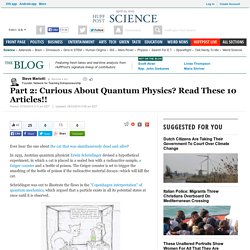
In 1935, Austrian quantum physicist Erwin Schrödinger devised a hypothetical experiment, in which a cat is placed in a sealed box with a radioactive sample, a Geiger counter and a bottle of poison. The Geiger counter is set to trigger the smashing of the bottle of poison if the radioactive material decays--which will kill the cat. Schrödinger was out to illustrate the flaws in the "Copenhagen interpretation" of quantum mechanics, which argued that a particle exists in all its potential states at once until it is observed. Schrödinger's Cat (source) As Schrödinger cleverly pointed out, the Copenhagen interpretation would imply that the radioactive material would simultaneously decay and not decay in its sealed, unobserved environment.
Since that's not possible, Schrödinger wrote that his hypothetical experiment "prevents us from so naively accepting as valid a 'blurred model' for representing reality. " 6. 7. 8. 9. 10. How It Works: Death By Black Hole. Welcome to Forbes. Scientists Discover a Jewel at the Heart of Quantum Physics. Physicists reported this week the discovery of a jewel-like geometric object that dramatically simplifies calculations of particle interactions and challenges the notion that space and time are fundamental components of reality.

“This is completely new and very much simpler than anything that has been done before,” said Andrew Hodges, a mathematical physicist at Oxford University who has been following the work. The revelation that particle interactions, the most basic events in nature, may be consequences of geometry significantly advances a decades-long effort to reformulate quantum field theory, the body of laws describing elementary particles and their interactions. New Measurements Show that the Unrealest Part of Quantum Physics Is Very Real. Subatomic particle-points in the quantum world like to behave as clouds of possibilities (waves) rather than points, a feature of “wave-particle duality,” and the interpretation of this is an open question and a source of great discomfort among physicists.
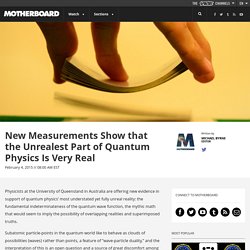
The new research suggests it may just turn out that weirdest part of it is really as strange and counterintuitive as it looks. Some background: Quantum physics and all of its apparent oddities and quirks boil down to waves. Reality, when left to its own devices, is indeterminate. Here and there are really probably here and probably there; is or isn’t is really probably is and probably isn’t.
Image: uoregon.edu All of this probability is given by wave functions, which are really, truly the most important thing. Matt Liefer, a researcher at the Perimeter Institute for Theoretical Physics in Ontario, has a good explanation of the whole wave function/reality mess on his website. Image: Wikimedia Commons Think about what that means. Nothing is solid: This is the world of Quantum Physics.
Nobel Prize winning physicists have proven beyond doubt that the physical world is one large sea of energy that flashes into and out of being in milliseconds, over and over again.

Nothing is solid. Plans for a secure quantum internet take a leap forward. Scientists have created a device that can release a single, precisely shaped photon of light, opening the way to a secure “quantum internet” that is incredibly powerful and impenetrable to hackers.
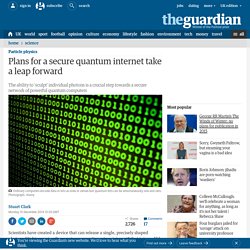
The vision is of a future network of quantum computers that can work together to solve problems beyond the capabilities of current machines. The key to developing a quantum internet is the ability to encode information on single photons of light that can be produced on demand. Now Prof Andrea Fiore of Eindhoven University of Technology and colleagues have developed a nanoscale device that can do this by “sculpting” the shape of individual photons. “This is a very important step to be able to produce single photons exactly when you want them,” said Prof Chris Phillips from Imperial College, London, who wasn’t involved in the research. Quantum networks are highly sought after by governments around the world because they can make communication between two computers impenetrable to hackers. The Question That Could Unite Quantum Theory With General Relativity: — The P...
One of the big problems with quantum gravity is that it generates infinities that have no physical meaning.
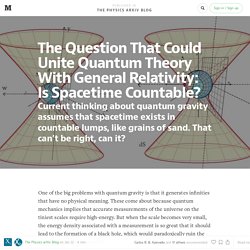
These come about because quantum mechanics implies that accurate measurements of the universe on the tiniest scales require high-energy. But when the scale becomes very small, the energy density associated with a measurement is so great that it should lead to the formation of a black hole, which would paradoxically ruin the measurement that created it. These kinds of infinities are something of an annoyance. Their paradoxical nature makes them hard to deal with mathematically and difficult to reconcile with our knowledge of the universe, which as far as we can tell, avoids this kind of paradoxical behaviour. So physicists have invented a way to deal with infinities called renormalisation. Sub-Structure of the Electron and Mass Relation of Leptons and Nucleons.
The Mathematics of Quantum Atom Theory. Is Quantum Entanglement Real? QUANTUM PHYSICS 2. Do Parallel Worlds Interact with One Another? The Engineer posted on October 31, 2014 | Comment | 792 views Griffith University academics are challenging the foundations of quantum science with a radical new theory based on the existence of, and interactions between, parallel universes.
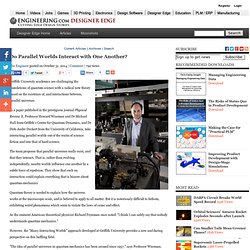
In a paper published in the prestigious journal Physical Review X, Professor Howard Wiseman and Dr Michael Hall from Griffith's Centre for Quantum Dynamics, and Dr Dirk-Andre Deckert from the University of California, take interacting parallel worlds out of the realm of science fiction and into that of hard science. The team proposes that parallel universes really exist, and that they interact. An infinite multiverse: a bad idea or inescapable? Earlier this week, a cultural center in Red Hook, Brooklyn played host to the sort of debate that's usually reserved for smoke-filled dorm rooms: do we live in a multiverse and, if so, is there another you out there?
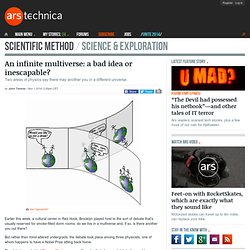
But rather than mind-altered undergrads, the debate took place among three physicists, one of whom happens to have a Nobel Prize sitting back home. The debate was held at Pioneer Works, a nonprofit center that places artists' studios next to a space for scientists-in-residence, mixing in a high-tech microscopy company and 3D printers for good measure. It's mostly known for the classes it offers, which range from crafts from lockpicking and programming to learning how to play a theramin. But Pioneer Works is starting a series on controversial scientific topics, and the multiverse is the first one it chose to tackle. It made some excellent choices to handle it. Many worlds, v1.0. Astro & quantum physics. Quantum. Quantum Mechanics. EmDrive Is an Engine That Breaks the Laws of Physics and Could Take Us to Mars. An experimental engine is gaining acceptance among scientists, and could introduce a new era of space travel — it only had to break a law of physics to do so.
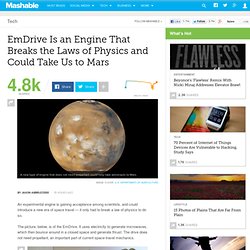
The picture, below, is of the EmDrive. It uses electricity to generate microwaves, which then bounce around in a closed space and generate thrust. The drive does not need propellant, an important part of current space-travel mechanics. The force generated by the drive is not particularly strong, but the implications are big. Multiple independent experiments have now replicated the drive's ability to generate thrust, albeit with varying success. Will Science Burst the Multiverse's Bubble? Physicists aren’t afraid of thinking big, but what happens when you think too big?
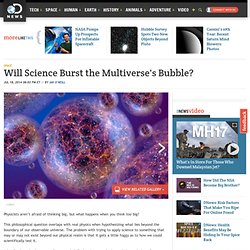
This philosophical question overlaps with real physics when hypothesizing what lies beyond the boundary of our observable universe. When a Black Hole Dies, Is a White Hole Born? Do black holes die? And if so, what happens when they're gone? A new theory suggests that these galactic vacuums hit a point at which they can collapse no further. At this moment, a black hole ceases to exist, and it explodes into its exact opposite: a white hole. Like a galactic purge, all the matter and light sucked in by the black hole is now spewed outward. White holes aren’t new to the science world. Quantum split: Particle this way, properties that way - physics-math - 23 Jul... Quantum Thoughts. A quantum (computing) gun revealed by quantum smoke. I have to admit it: D-Wave is starting to produce some impressive results. For the uninitiated, D-Wave came to our attention by loudly and repeatedly claiming that it had built a quantum computer.
Many of us were skeptical. Over time, though, D-Wave has answered its critics in the best way possible: by providing evidence. Now, researchers who actually got inside the black box are reporting some key results that come very close to removing any lingering doubts. The quantum difference When we perform computations in an ordinary computer, we have to manipulate each bit individually. Matter will be created from light within a year, claim scientists. Researchers have worked out how to make matter from pure light and are drawing up plans to demonstrate the feat within the next 12 months.
The theory underpinning the idea was first described 80 years ago by two physicists who later worked on the first atomic bomb. At the time they considered the conversion of light into matter impossible in a laboratory. But in a report published on Sunday, physicists at Imperial College London claim to have cracked the problem using high-powered lasers and other equipment now available to scientists. "We have shown in principle how you can make matter from light," said Steven Rose at Imperial. "If you do this experiment, you will be taking light and turning it into matter.
" Scientists achieve reliable quantum teleportation for first time. Albert Einstein once told a friend that quantum mechanics doesn't hold water in his scientific world view because "physics should represent a reality in time and space, free from spooky actions at a distance. " That spooky action at a distance is entanglement, a quantum phenomenon in which two particles, separated by any amount of distance, can instantaneously affect one another as if part of a unified system. Now, scientists have successfully hijacked that quantum weirdness -- doing so reliably for the first time -- to produce what many sci-fi fans have long dreamt up: teleportation.
No, not beaming humans aboard the USS Enterprise, but the teleportation of data.